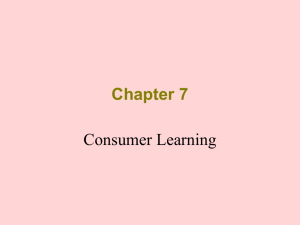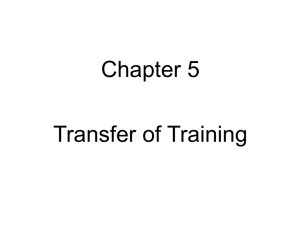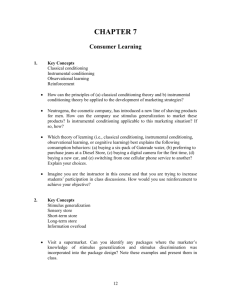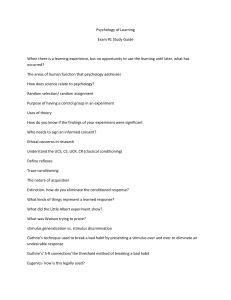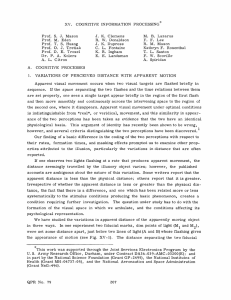File
advertisement
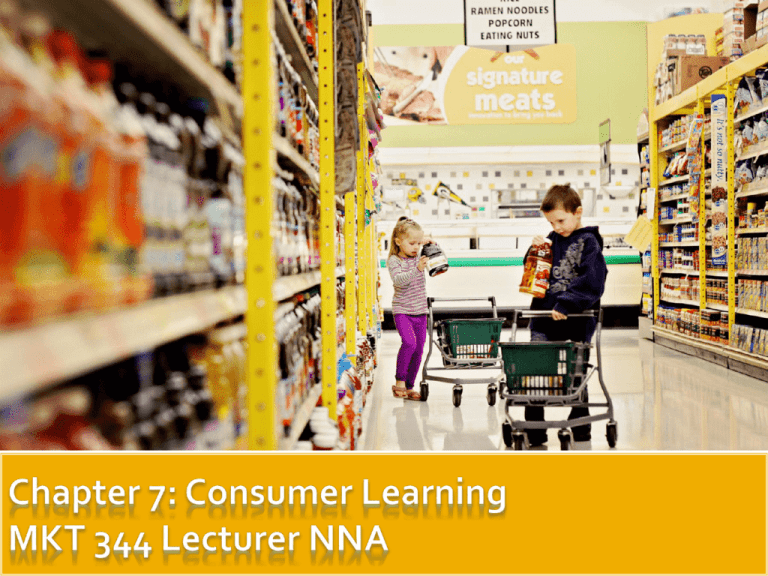
Consumer Behavior, Ninth Edition Schiffman & Kanuk The Elements of Consumer Learning Behavioral Learning Theories Cognitive Learning Theory Measures of Consumer Learning The process by which individuals acquire the purchase and consumption knowledge and experience that they apply to future related behavior Marketers must teach consumers: where to buy how to use how to maintain how to dispose of products Behavioral Theories Based on observable behaviors (responses) that occur as the result of exposure to stimuli Cognitive Theories Learning based on mental information processing Often in response to problem solving Motivation Cues Response Reinforcement Classical Conditioning Instrumental Conditioning Modeling or Observational Learning Classical Conditioning A behavioral learning theory according to which a stimulus is paired with another stimulus that elicits a known response that serves to produce the same response when used alone. We now associate this product with strength. Basic Concepts Repetition Increases the association between the conditioned and unconditioned stimulus Slows the pace of forgetting Advertising wearout is a problem Basic Concepts Stimulus generalization Having the same response to slightly different stimuli Helps “me-too” products to succeed Basic Concepts Stimulus generalization Useful in product extensions Line extension Form extension Category extension Basic Concepts Stimulus generalization Family brand Marketing a whole line of company products under the same brand name Retail Private Brand Licensed brand Basic Concepts Stimulus discrimination Selection of a specific stimulus from similar stimuli This discrimination is the basis of positioning which looks for unique ways to fill needs Instrumental (Operant) Conditioning A behavioral theory of learning based on a trial-and-error process, with habits forced as the result of positive experiences (reinforcement) resulting from certain responses or behaviors. Positive Negative Forgetting Extinction Customer Satisfaction (Reinforcement) Reinforcement Schedules Total (continuous) Systematic (fixed ratio) Random (variable ratio) Shaping Massed versus Distributed Learning Observational Learning A process by which individuals observe how others behave in response to certain stimuli and reinforcements. Also known as modeling or vicarious learning. Cognitive Learning Theory Holds that the kind of learning most characteristic of human beings is problem solving, which enables individuals to gain some control over their environment. Relates to cognitive ability and the complexity of the information Individuals differ in imagery – their ability to form mental images which influences recall Information Processing and Memory Stores - Figure 7.14 Movement from short-term to long-term storage depends on Rehearsal Encoding Table 7.1 Models of Cognitive Learning Sequential Stages of Processing Promotional Model Tricompetent Model DecisionMaking Model Attention Cognitive Awareness Knowledge Interest Desire Affective Action Conative Evaluation Purchase Postpurchase Evaluation Innovation Adoption Model Innovation Decision Process Awareness Knowledge Interest Evaluation Persuasion Trial Adoption Decision Confirmation Consumer Relevance Central and Peripheral Routes to Persuasion Measure of Involvement Involvement depends on degree of personal relevance. High involvement is: Very important to the consumer Provokes extensive problem solving Central route to persuasion For high involvement purchases Requires cognitive processing Peripheral route to persuasion Low involvement Consumer less motivated to think Learning through repetition, visual cues, and holistic perception Peripheral route to persuasion Four types of loyalty No loyalty ▪ No purchase ▪ No cognitive attachment Covetous loyalty ▪ No purchase ▪ Strong attachment Inertia loyalty ▪ No emotional attachment ▪ Purchase by habit Premium loyalty ▪ High attachment ▪ High repeat purchase
